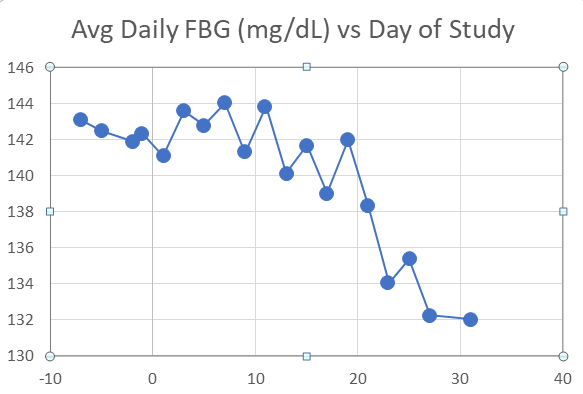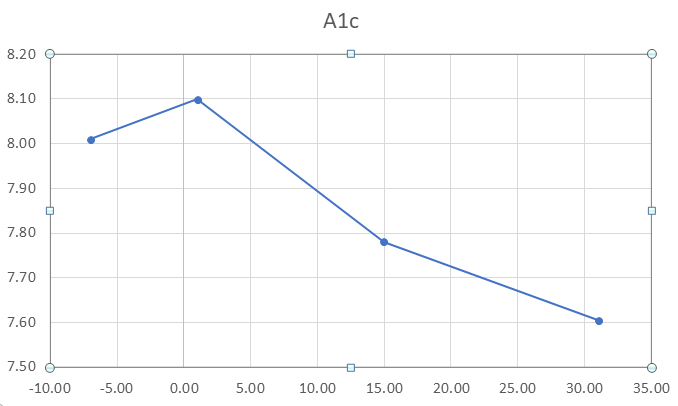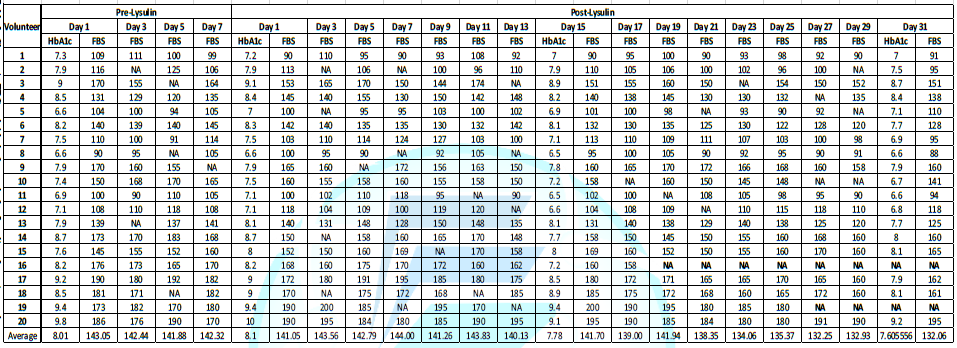Review Article :
When a diabetes treatment is changed, patients
are eager to see their FBG and A1c changes as a result on the new
treatment. We examined these changes in
20 subjects with Type 2 diabetes for 1 week prior to starting Lysulin and then
for the following 30 days.While both
FBG and A1c drop in less than 1 month, the change in A1c was more rapid than
the change if FBG.Possible reasons for
the differences between FBG and A1c are presented. Glucose is essential in providing the human body
its’ energy needs. Glucose
relies upon the hormone, insulin, to enter our cells thereby producing the
energy we need for everyday living.
However, while everyone needs a certain amount of glucose for daily
energy production, excessive glucose is dangerously toxic to the body
(primarily as a result of protein glycation). This leads to insulin resistance,
caused by the glycation of insulin and insulin receptors, thereby resulting in
high concentrations of glucose in the bloodstream [1]. The therapy for type 2
diabetes starts with attempts to control glucose through diet and exercise. If
this fails, oral
drugs are prescribed. If oral drugs do not work, insulin injections are
used. Over 30% of people with type
2 diabetes are using insulin injections to control their blood glucose
levels [2]. There is a vast literature documenting the role of nutraceuticals
in the management of alterations in metabolism [3]. A new nutritional supplement, Lysulin, was recently
introduced and is the only product that targets the cause on insulin
resistance and diabetes. When a treatment change is made, patients are
interested in how quickly they can observe a change in their FBG and A1c. This information is only available for insulin
injections, where the change in FBG can be seen in one day. We examined the change in FBG and A1c in 20
subjects with Type 2 diabetes for 1 week prior to starting 3 daily servings of Lysulin
and then continued testing for the following 30 days. The results for all subjects are presented in
Table 1. As shown in the Table 1, 70% of participants saw a
benefit (14 out of 20), 20% saw no change (4 folks) and 10% may have had an
increase, although slight. The average change in FBG is shown in Figure 1. As seen in Figure 1, the average FBG started
dropping after 14 day and had started to level off after 27 days. As shown in the Table 1, 65% of participants saw a benefit using Lysulin (13
out of 20), 25% (5 subjects) saw no change and 10% (2 subjects) may have had an
increase of greater than 4 mg/dL glucose. The change in Average A1c is shown in
Figure 2. Figure 1: Average Daily FBG (mg/dL) vs
Day of Study. Figure 2: Average A1c (%) vs Day of
Study. Table 1: Change in FBG and A1c before
and after Lysulin – 3 servings a day. As seen in Figure 2, the A1c was lower at 15 days
and continued to decrease at the day 31 test.
The reduction in A1c is statistically significant, with p=0.0004 at day
15, p=0.0002 at day 31. As shown in the
above table, 70% of participants saw a benefit using Lysulin (14 out of 20),
and 20% saw no change, 4 subjects had no change (+ 0.2 %) and 10% may have had
an increase, although slight. This is consistent with A1c drops seen in earlier
Lysulin
studies [4-6]. Interestingly, subject 20
had an A1c decrease of 9.8% to 9.2% but their FBG increased from 180 mg/dL to
187 mg/dL. Of more importance is the observation that 70% of
participants saw an improvement in their A1c.
There are several possible explanations why 100% did not see an
improvement in their A1c. The most
obvious would be a lack of compliance in taking the recommended 3 servings a
day of Lysulin or a change in diet,
exercise or lifestyle which could also effect glucose levels. Another possibility is that a certain
percentage of the population does not effectively move the 3 primary
ingredients in Lysulin from their gut into the bloodstream,
due to microbiome population in the gut or other reasons that are ruled by genetics
[7]. Another important finding was that A1c dropped more
quickly than did the FBG. This implies
that the daily average glucose dropped faster than the FBG. This finding has been reported by others–see http://www.ngsp.org/A1ceAG.asp which
concluded that post-lunch and bedtime glucose showed relationships to HbA1c
that were the most similar to 7 point glucose daily testing. Fasting glucose correlated less well and
results showed that with increasing HbA1c, fasting glucose progressively
underestimated the HbA1c level. Summary
and Conclusion This study compared the change in FBG and A1c
following a change in treatment. The results are that FBG changes can be
observed in 2 to 3 weeks and changes in A1c can be observed in as little as 2
weeks. This substantiates both the use
of Lysulin for type 2 diabetes and the use of A1c to measure the effectiveness
of changes in diabetes therapy [8]. References 1. Rhinesmith
T, Turkete T, and Root-Bernstein R. Rapid non-enzymatic glycation of the
insulin receptor under hyperglycemic conditions inhibits insulin binding in
vitro: implications for insulin resistance (2017) Int J Mol Sci. 18: 2602-2612. https://doi.org/10.3390/ijms18122602 2. https://www.cdc.gov/diabetes/data/statistics/statistics-
report.html 3. Scicchitano
P, Cameli M, Maria Maiello M , Modesti PA, uiesan ML, et.al. Nutraceuticals and
dyslipidaemia: Beyond the common therapeutics (2014) J Functional Foods 6:
11-32. https://doi.org/10.1016/j.jff.2013.12.006
4. Burd
J. Lysulin™, A new supplement for nutritional support for people with diabetes
and pre-diabetes (those at risk of developing diabetes) (2018) Diabetes
Management 8: 38-40. 5. Burd
JF, Noetzel V, Gonzalez A and Melero FAA. Lysulin®: A double-blind placebo
controlled pilot study of daily oral supplementation in people with type 2
diabetes (2018) Diabetes Management 8: 154-162. 6. Burd
JF, Alvarez Malero FA, and Nortzel V. Hemoglobin A1c (HbA1c) shows improvement
in glycemic control in as little as two weeks following the addition of Lysulin
to the treatment of diabetes (2018) Diabetes Management 8: 82-84. 7. Jafarnejad
A, Bathaie SZ, Nakhjavani M, Hassan MZ and Banasadegh S. The improvement effect
of L-Lys as a chemical chaperone on STZ-induced diabetic rats, protein
structure and function (2018) Diabetes/Metabolism Research and Reviews 24:
64-73. https://doi.org/10.1002/dmrr. 8. Klonoff
DC, Bergenstal RM, Cole TG, Bohannon NJV, Ammirati EB, et.al. Clinical
evaluation of a rapid A1C test (A1cNow) for home use (2016) Point Care 5:
116-120. https://doi.org/10.1097/01.poc.0000232578.91019.03 *Corresponding
author: John F Burd, Lysulin, Inc., 3525A
Del Mar Heights Road, Suite 398, San Diego, California, USA, Tel: 619-992-2873,
E-mail: jburd@jburd.com Burd JF. Both fasting blood glucose (FBG) and A1C
drop in less than one month after starting lysulin supplementation (2019) J
Obesity and Diabetes 3: 33-35. Lysulin, Type 2 diabetes, Glucose.Both Fasting Blood Glucose (FBG) and A1c Drop in Less than One Month after Starting Lysulin Supplementation
John F Burd
Abstract
Full-Text



Keywords